Page 273 of 345
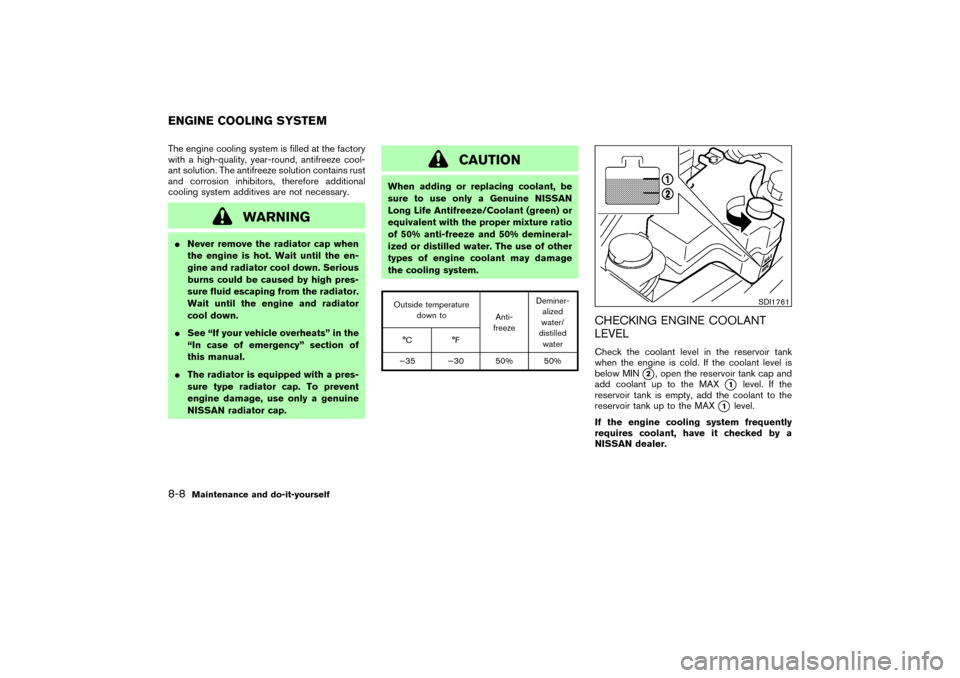
The engine cooling system is filled at the factory
with a high-quality, year-round, antifreeze cool-
ant solution. The antifreeze solution contains rust
and corrosion inhibitors, therefore additional
cooling system additives are not necessary.
WARNING
�Never remove the radiator cap when
the engine is hot. Wait until the en-
gine and radiator cool down. Serious
burns could be caused by high pres-
sure fluid escaping from the radiator.
Wait until the engine and radiator
cool down.
�See “If your vehicle overheats” in the
“In case of emergency” section of
this manual.
�The radiator is equipped with a pres-
sure type radiator cap. To prevent
engine damage, use only a genuine
NISSAN radiator cap.
CAUTION
When adding or replacing coolant, be
sure to use only a Genuine NISSAN
Long Life Antifreeze/Coolant (green) or
equivalent with the proper mixture ratio
of 50% anti-freeze and 50% demineral-
ized or distilled water. The use of other
types of engine coolant may damage
the cooling system.Outside temperature
down to
Anti-
freezeDeminer-
alized
water/
distilled
water °C °F
−35 −30 50% 50%
CHECKING ENGINE COOLANT
LEVELCheck the coolant level in the reservoir tank
when the engine is cold. If the coolant level is
below MIN
�2, open the reservoir tank cap and
add coolant up to the MAX
�1
level. If the
reservoir tank is empty, add the coolant to the
reservoir tank up to the MAX
�1
level.
If the engine cooling system frequently
requires coolant, have it checked by a
NISSAN dealer.
SDI1761
ENGINE COOLING SYSTEM8-8
Maintenance and do-it-yourself
�
06.7.5/Z50-D/V5.0
�
Page 274 of 345
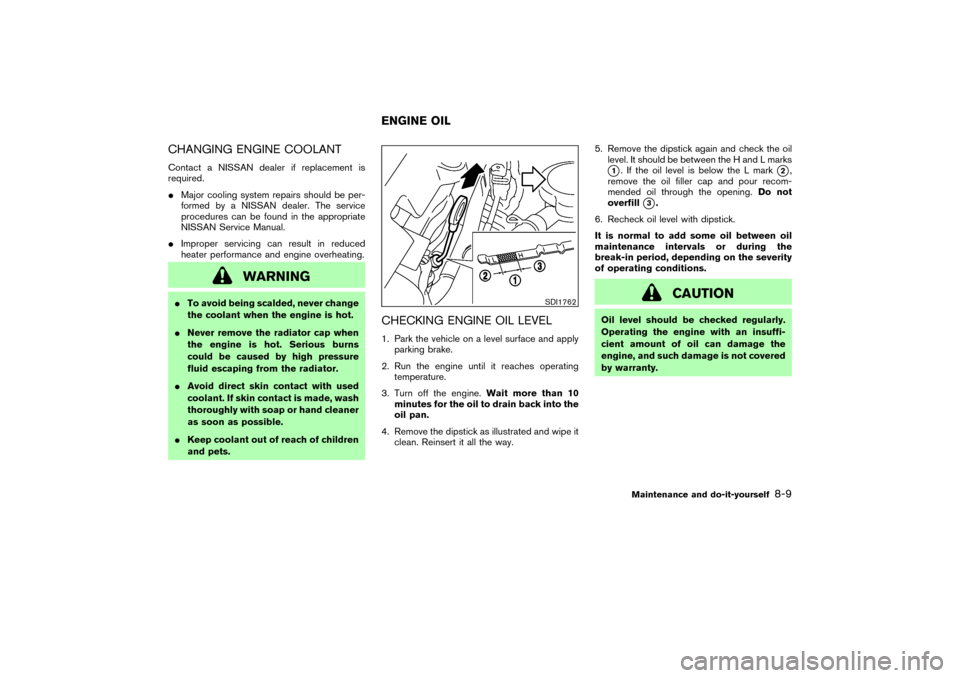
CHANGING ENGINE COOLANTContact a NISSAN dealer if replacement is
required.
�Major cooling system repairs should be per-
formed by a NISSAN dealer. The service
procedures can be found in the appropriate
NISSAN Service Manual.
�Improper servicing can result in reduced
heater performance and engine overheating.
WARNING
�To avoid being scalded, never change
the coolant when the engine is hot.
�Never remove the radiator cap when
the engine is hot. Serious burns
could be caused by high pressure
fluid escaping from the radiator.
�Avoid direct skin contact with used
coolant. If skin contact is made, wash
thoroughly with soap or hand cleaner
as soon as possible.
�Keep coolant out of reach of children
and pets.
CHECKING ENGINE OIL LEVEL1. Park the vehicle on a level surface and apply
parking brake.
2. Run the engine until it reaches operating
temperature.
3. Turn off the engine.Wait more than 10
minutes for the oil to drain back into the
oil pan.
4. Remove the dipstick as illustrated and wipe it
clean. Reinsert it all the way.5. Remove the dipstick again and check the oil
level. It should be between the H and L marks
�1. If the oil level is below the L mark
�2,
remove the oil filler cap and pour recom-
mended oil through the opening.Do not
overfill
�3.
6. Recheck oil level with dipstick.
It is normal to add some oil between oil
maintenance intervals or during the
break-in period, depending on the severity
of operating conditions.
CAUTION
Oil level should be checked regularly.
Operating the engine with an insuffi-
cient amount of oil can damage the
engine, and such damage is not covered
by warranty.
SDI1762
ENGINE OIL
Maintenance and do-it-yourself
8-9
�
06.7.5/Z50-D/V5.0
�
Page 276 of 345
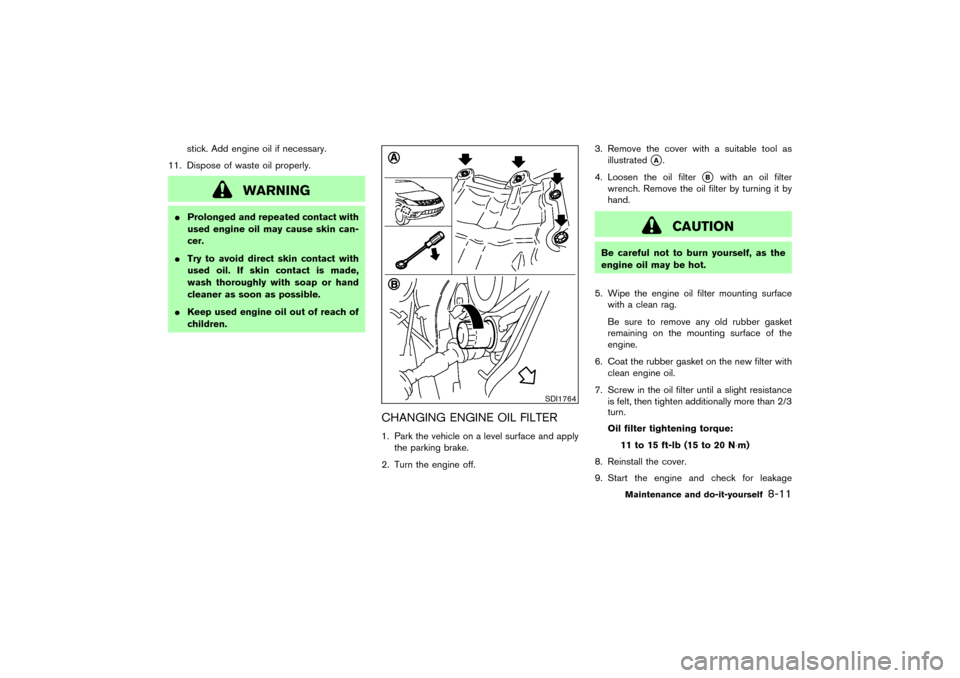
stick. Add engine oil if necessary.
11. Dispose of waste oil properly.
WARNING
�Prolonged and repeated contact with
used engine oil may cause skin can-
cer.
�Try to avoid direct skin contact with
used oil. If skin contact is made,
wash thoroughly with soap or hand
cleaner as soon as possible.
�Keep used engine oil out of reach of
children.
CHANGING ENGINE OIL FILTER1. Park the vehicle on a level surface and apply
the parking brake.
2. Turn the engine off.3. Remove the cover with a suitable tool as
illustrated
�A.
4. Loosen the oil filter
�B
with an oil filter
wrench. Remove the oil filter by turning it by
hand.
CAUTION
Be careful not to burn yourself, as the
engine oil may be hot.
5. Wipe the engine oil filter mounting surface
with a clean rag.
Be sure to remove any old rubber gasket
remaining on the mounting surface of the
engine.
6. Coat the rubber gasket on the new filter with
clean engine oil.
7. Screw in the oil filter until a slight resistance
is felt, then tighten additionally more than 2/3
turn.
Oil filter tightening torque:
11 to 15 ft-lb (15 to 20 N⋅m)
8. Reinstall the cover.
9. Start the engine and check for leakage
SDI1764
Maintenance and do-it-yourself
8-11
�
06.7.5/Z50-D/V5.0
�
Page 278 of 345
lent.For additional brake fluid specification informa-
tion, refer to “Capacities and recommended
fuel/lubricants” in the “9. Technical and con-
sumer information” section of this manual.
WARNING
Old, inferior or contaminated fluid may
damage the brake system. The use of
improper fluids can damage the brake
system and affect the vehicle’s stopping
ability.
CAUTION
Do not spill the fluid on any painted
surfaces. This will damage the paint. If
fluid is spilled, immediately wash the
surface with water.Check the fluid level in the reservoir. If the fluid is
below the MIN line
�2or the brake warning light
comes on, add Genuine NISSAN Super Heavy
Duty Brake Fluid or equivalentDOT 3fluid up to
the MAX line
�1. If fluid must be added fre-
quently, the system should be thoroughly
checked by a NISSAN dealer.
SDI1766
BRAKE FLUID
Maintenance and do-it-yourself
8-13
�
06.7.5/Z50-D/V5.0
�
Page 279 of 345
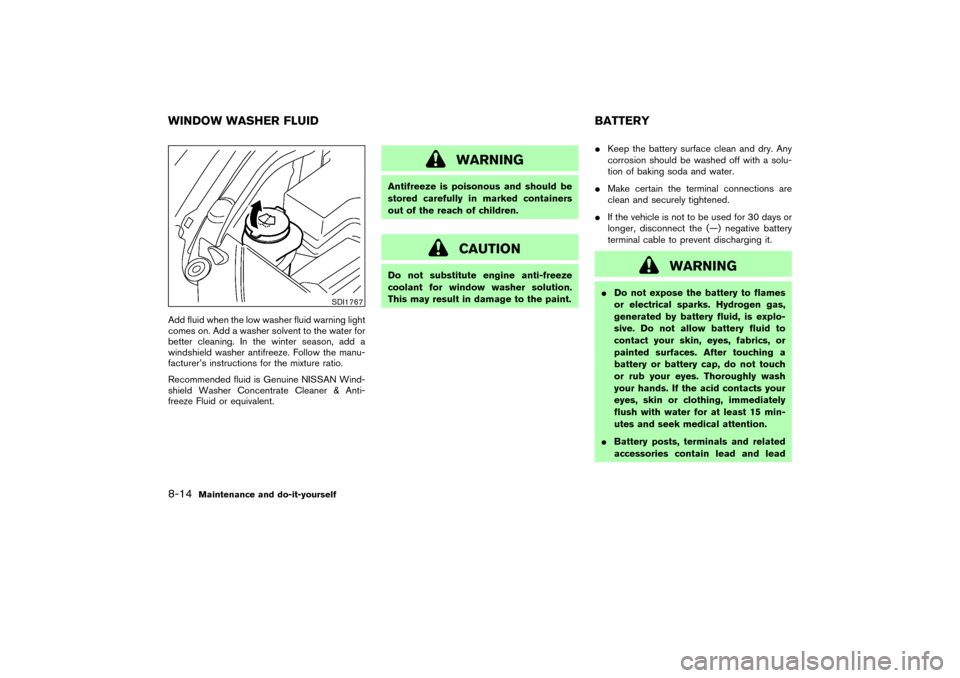
Add fluid when the low washer fluid warning light
comes on. Add a washer solvent to the water for
better cleaning. In the winter season, add a
windshield washer antifreeze. Follow the manu-
facturer’s instructions for the mixture ratio.
Recommended fluid is Genuine NISSAN Wind-
shield Washer Concentrate Cleaner & Anti-
freeze Fluid or equivalent.
WARNING
Antifreeze is poisonous and should be
stored carefully in marked containers
out of the reach of children.
CAUTION
Do not substitute engine anti-freeze
coolant for window washer solution.
This may result in damage to the paint.�Keep the battery surface clean and dry. Any
corrosion should be washed off with a solu-
tion of baking soda and water.
�Make certain the terminal connections are
clean and securely tightened.
�If the vehicle is not to be used for 30 days or
longer, disconnect the (—) negative battery
terminal cable to prevent discharging it.
WARNING
�Do not expose the battery to flames
or electrical sparks. Hydrogen gas,
generated by battery fluid, is explo-
sive. Do not allow battery fluid to
contact your skin, eyes, fabrics, or
painted surfaces. After touching a
battery or battery cap, do not touch
or rub your eyes. Thoroughly wash
your hands. If the acid contacts your
eyes, skin or clothing, immediately
flush with water for at least 15 min-
utes and seek medical attention.
�Battery posts, terminals and related
accessories contain lead and lead
SDI1767
WINDOW WASHER FLUID BATTERY8-14
Maintenance and do-it-yourself
�
06.7.5/Z50-D/V5.0
�
Page 281 of 345
WARNING
Be sure the ignition key is in the OFF or
LOCK position. The engine could rotate
unexpectedly.
1. Power steering oil pump
2. Idler pulley
3. Alternator
4. Crankshaft pulley
5. Air conditioner compressor
�: Tension checking pointsVisually inspect each belt for signs of unusual
wear, cuts, fraying, oil adhesion or looseness. If
the belt is in poor condition or loose, have it
replaced or adjusted by a NISSAN dealer.
Have the belts checked regularly for condition
and tension.
WARNING
Be sure the engine and ignition switch
are off and that the parking brake is
engaged securely.
CAUTION
Be sure to use the correct socket to
remove the spark plugs. An incorrect
socket can damage the spark plugs.
SDI0141B
DRIVE BELTS SPARK PLUGS8-16
Maintenance and do-it-yourself
�
06.7.5/Z50-D/V5.0
�
Page 282 of 345
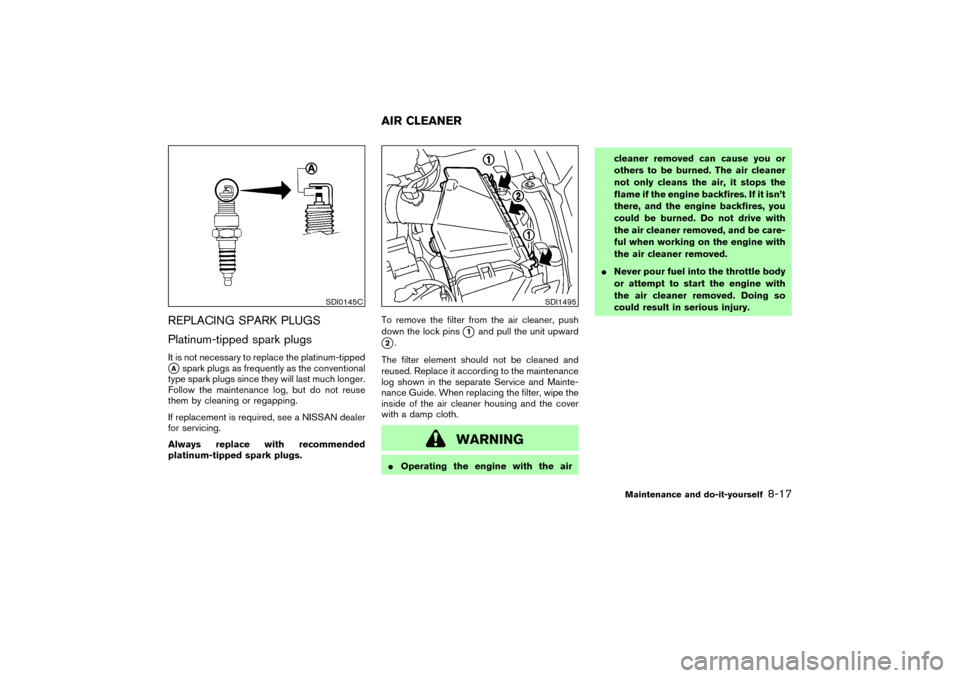
REPLACING SPARK PLUGS
Platinum-tipped spark plugsIt is not necessary to replace the platinum-tipped�Aspark plugs as frequently as the conventional
type spark plugs since they will last much longer.
Follow the maintenance log, but do not reuse
them by cleaning or regapping.
If replacement is required, see a NISSAN dealer
for servicing.
Always replace with recommended
platinum-tipped spark plugs.To remove the filter from the air cleaner, push
down the lock pins
�1
and pull the unit upward
�2.
The filter element should not be cleaned and
reused. Replace it according to the maintenance
log shown in the separate Service and Mainte-
nance Guide. When replacing the filter, wipe the
inside of the air cleaner housing and the cover
with a damp cloth.
WARNING
�Operating the engine with the aircleaner removed can cause you or
others to be burned. The air cleaner
not only cleans the air, it stops the
flame if the engine backfires. If it isn’t
there, and the engine backfires, you
could be burned. Do not drive with
the air cleaner removed, and be care-
ful when working on the engine with
the air cleaner removed.
�Never pour fuel into the throttle body
or attempt to start the engine with
the air cleaner removed. Doing so
could result in serious injury.
SDI0145C
SDI1495
AIR CLEANER
Maintenance and do-it-yourself
8-17
�
06.7.5/Z50-D/V5.0
�
Page 285 of 345
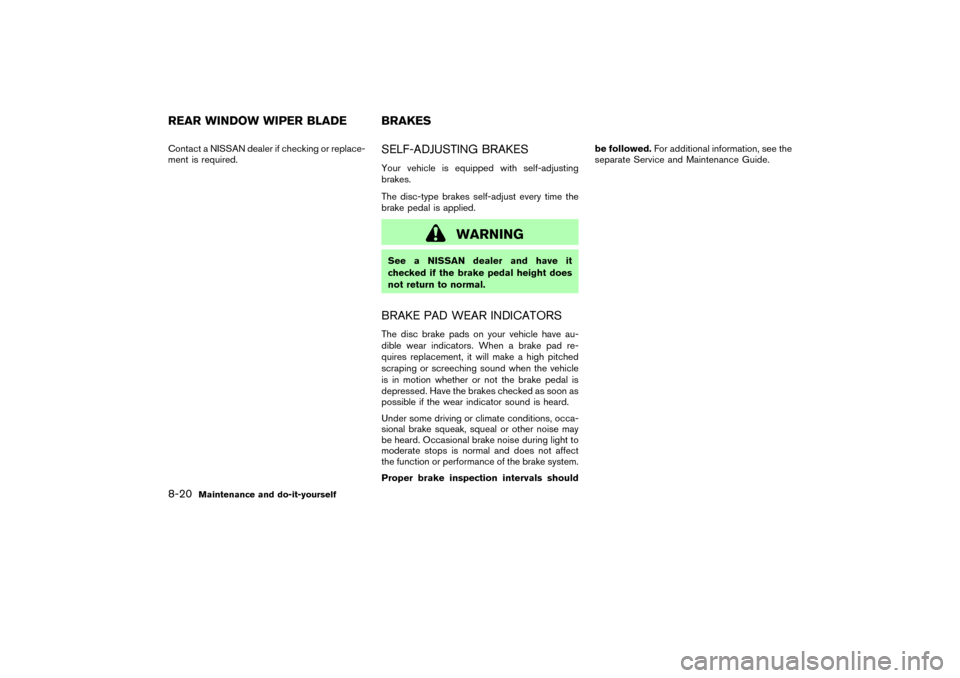
Contact a NISSAN dealer if checking or replace-
ment is required.
SELF-ADJUSTING BRAKESYour vehicle is equipped with self-adjusting
brakes.
The disc-type brakes self-adjust every time the
brake pedal is applied.
WARNING
See a NISSAN dealer and have it
checked if the brake pedal height does
not return to normal.BRAKE PAD WEAR INDICATORSThe disc brake pads on your vehicle have au-
dible wear indicators. When a brake pad re-
quires replacement, it will make a high pitched
scraping or screeching sound when the vehicle
is in motion whether or not the brake pedal is
depressed. Have the brakes checked as soon as
possible if the wear indicator sound is heard.
Under some driving or climate conditions, occa-
sional brake squeak, squeal or other noise may
be heard. Occasional brake noise during light to
moderate stops is normal and does not affect
the function or performance of the brake system.
Proper brake inspection intervals shouldbe followed.For additional information, see the
separate Service and Maintenance Guide.
REAR WINDOW WIPER BLADE BRAKES8-20
Maintenance and do-it-yourself
�
06.7.5/Z50-D/V5.0
�